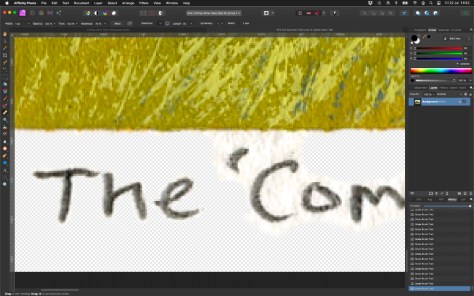Today I started digital editing a scan of a wee 7“x5” gouache painting called ’The Coming Home Trees’. Travelling to Cornwall on the A30 they are a much-loved landmark. They are also called ‘The Nearly There Trees’. This was one of the paintings made when I was painting sets.

When I ran an Instagram poll months back asking whether people would prefer prints or cards of my paintings. Prints clearly came out on top. Unfortunately at the time I was unable to progress.
Piggy bank willing, I’m now ready to fund a small run of high quality Giclee prints. Giclee prints are made using top-of-the-line inkjet printers which can print onto watercolour paper. While the technology is similar to your home deskjet printer, Giclee printers use 12 or more inks rather than 4. This means they achieve very subtle colour graduations which closely match those in the original painting. It can sometimes be difficult to tell a Giclee print from the original, they are that good.
My process
I scan all my paintings as soon as I complete them so I already had a hi-res 32 bit TIF file. My goal today is to remove some of the unnecessary scanned texture from areas of blank paper while retaining the original raggedy edge left by the masking tape. I‘m also cleaning around the pencil writing.


Mucking about like this reminds me of being back at work where Photoshop was a constant companion. These days I use the excellent Affinity Photo by Serif who also publish the companion programs Affinity Designer and Affinity Publisher. Admittedly the interface can be a little confusing if you’re coming from Photoshop, but with a little time and YouTube videos all becomes clear.
All are very reasonably priced too. Photo does all of what I asked of Photoshop for but at a fraction of the cost. A real biggy for me is that Serif don’t hold you to ransom with a subscription like Adobe.
I’ll composite and position my edited image onto a 10”x8” blank digital master ready for printing. And to ensure the colours and tones remain faithful to the original I’ll be arranging a test print.
When will ‘The Coming Home Trees’ be available?
Soon I hope. I’ve got to source a printer then as long as I’m happy with a test print I’ll list them in my Etsy shop. They will be 10″x8″ total size with the image life-size at around 5″x4″. They will come with a card window mount and there will be an option to have them framed.
Meanwhile, here’s a simulation to whet your appetite (final version might vary):

See you soon,
Ade, 22 July 2022
































